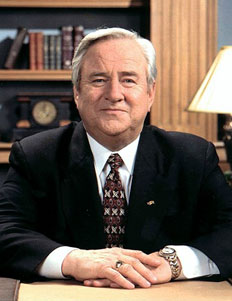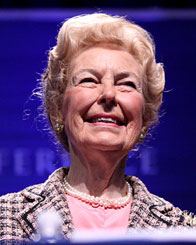The 1970s had been an explosive and difficult decade within the United States. The nation had endured a scandalous presidency, the end of the Vietnam War, and an economic crisis. The decade ended with the failure of President Jimmy Carter's economic policy to curb high inflation. Carter made positive strides towards peace in the Middle East with his foreign policies, but his handling of the Iran hostage crisis left 52 captive Americans in Iran for more than a year, reduced American prestige, and heightened tensions in the Middle East and beyond.
![]() Many Americans looked forward to economic, social, and political change in the 1980s. The images below represent the 1980s. Scroll over each image to learn more.
Many Americans looked forward to economic, social, and political change in the 1980s. The images below represent the 1980s. Scroll over each image to learn more.
The election of Ronald Reagan was the first significant political change in the 1980s. Reagan, a Republican president who served two terms, represented a new conservative political movement. Many of those who were part of the rise in conservatism supported Reagan because he promised to reduce taxes, limit government interference in business, and restore traditional American values.
Many individuals and organizations with conservative values sided with Reagan and pushed for public policies that reflected conservative values and principles. The Heritage Foundation, a research and educational institute that promotes conservative public policies, was especially active during the Reagan Administration.
Read about the mission of the Heritage Foundation in the excerpts from the foundation’s website.
"Founded in 1973, The Heritage Foundation is a research and educational institution—a think tank—whose mission is to formulate and promote conservative public policies based on the principles of free enterprise, limited government, individual freedom, traditional American values, and a strong national defense."
"Our vision is to build an America where freedom, opportunity, prosperity, and civil society flourish."
-exerpt from The Heritage Foundation
Click on the link above to read more about the Heritage Foundation.
Answer the following questions in your notes.
Interactive popup. Assistance may be required.
The Heritage Foundation bases its public policies on “free enterprise, limited government, individual freedom, traditional American values, and a strong national defense.”
Interactive popup. Assistance may be required.
The audiences of the Heritage Foundation’s messages are “members of Congress, key congressional staff members, policymakers in the executive branch, the nation’s news media, and the academic and policy communities.”
Interactive popup. Assistance may be required.
The principles of the Heritage Foundation that are similar to Tocqueville’s crucial values are free enterprise, limited government, and individual freedom.
There were individuals who were key to the rise of conservatism in American society during the 1980s.

In 1979, Reverend Jerry Falwell, a conservative Christian preacher, cofounded an organization called the "Moral Majority." The Moral Majority was based upon Falwell’s idea that Americans wanted to change social issues that some thought were ruining the traditional values of America.
The political movement of the Moral Majority was characterized as pro-America, pro-life, and pro-traditional values. The Moral Majority blended conservative politics with religious beliefs. Falwell and the Moral Majority had millions of donors and even more members who supported the organization’s causes.
The Moral Majority held political rallies to promote the organization’s beliefs. In 1980, the Moral Majority successfully campaigned for the presidential election of Ronald Reagan and other congressional candidates. The organization supported Reagan until he left office in 1989. The Moral Majority represented the political impact of conservatives in the 1980s.

Another individual who impacted the rise of the conservatives was Phyllis Schlafly. A lawyer and author, Schlafly became a leader in the conservative movement in the 1970s. Schlafly organized STOP ERA, a campaign to stop passage of the Equal Rights Amendment (ERA). (Click here to see the full text of the proposed Interactive popup. Assistance may be required.
).
Text of the Equal Rights Amendment
Section 1. Equality of rights under the law shall not be denied or abridged by the United States or by any state on account of sex.
Section 2. The Congress shall have the power to enforce, by appropriate legislation, the provisions of this article.
Section 3. This amendment shall take effect two years after the date of ratification.  She also founded Eagle Forum, an organization of volunteers who worked on creating and promoting public policy based on conservative beliefs.
She also founded Eagle Forum, an organization of volunteers who worked on creating and promoting public policy based on conservative beliefs.
Click on the link below to watch a video clip of Schlafly as she discusses her opposition to the Equal Rights Amendment.
Analyzing the video - According to the clip, what was the main issue of the Equal Rights Amendment that Schlafly opposed?
Interactive popup. Assistance may be required.
According to the clip, Schlafly was opposed to women in combat in the Armed Forces.
These conservative leaders were extremely active during the 1980s, and they continued to promote conservative public policies and to support elected officials during the 1990s.
Sources for the images used in this section, as they appear, top to bottom: